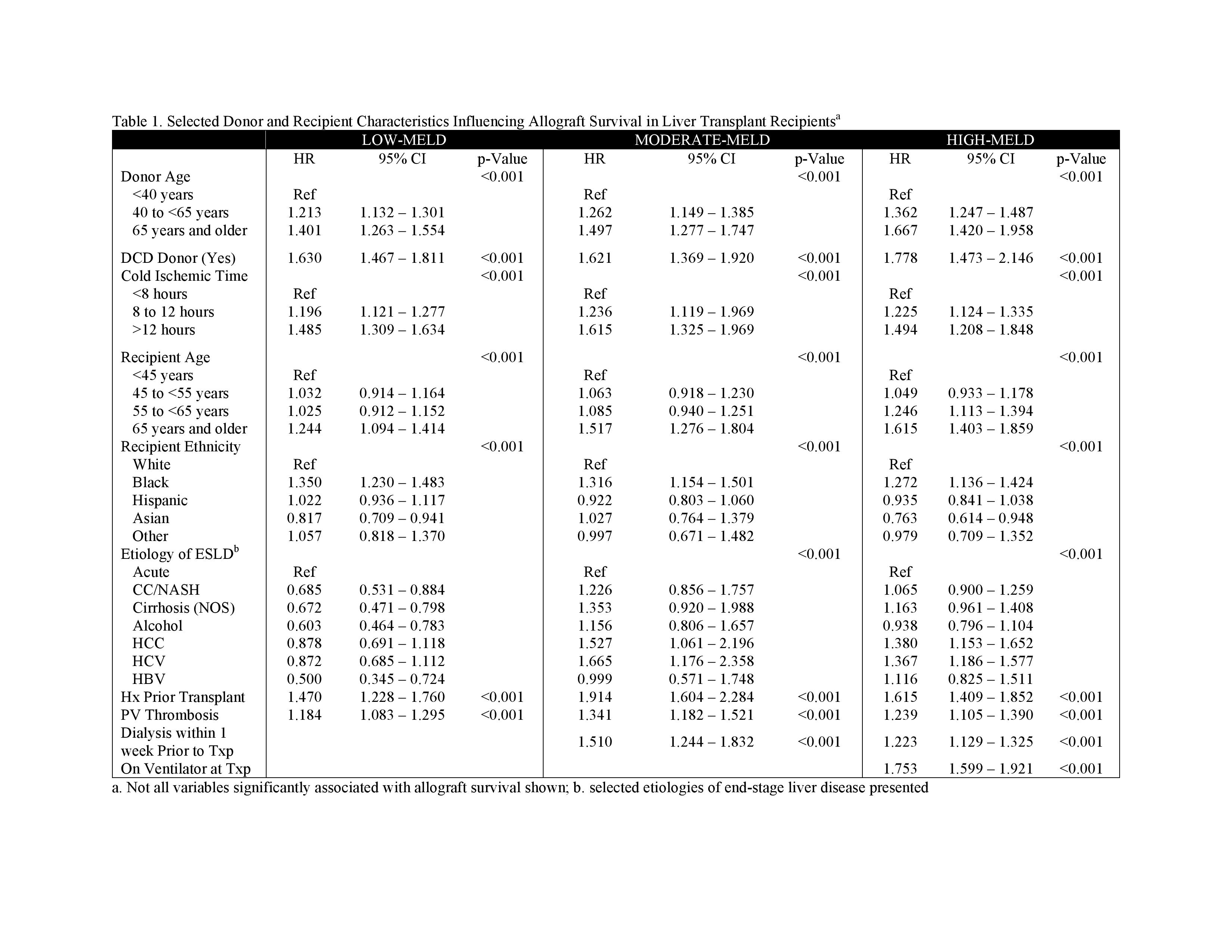Risk Factors for Graft Loss Vary with Recipient MELD Score in Liver Transplantation
1Surgery, Cedars-Sinai Medical Center, Los Angeles, Los Angeles, CA, 2Transplant Surgery, Cedars-Sinai Medical Center, Los Angeles, Los Angeles, CA
Meeting: 2019 American Transplant Congress
Abstract number: C277
Keywords: Donors, marginal, Graft survival, High-risk
Session Information
Session Name: Poster Session C: Liver: MELD, Allocation and Donor Issues (DCD/ECD)
Session Type: Poster Session
Date: Monday, June 3, 2019
Session Time: 6:00pm-7:00pm
 Presentation Time: 6:00pm-7:00pm
Presentation Time: 6:00pm-7:00pm
Location: Hall C & D
*Purpose: Risk factors for allograft loss in liver transplantation have previously been described. Less is known how these vary and interact amongst recipients with different MELD scores.
*Methods: The UNOS Standard Transplant Analysis and Research database was analyzed for deceased donor liver transplants between 2006 and 2016. Transplants were stratified by Na-MELD into three groups, with the highest group reflecting new allocation policies: Low (<25), Moderate (25-31), and High (>32 and Status 1A). Cox proportional hazards modeling identified donor and recipient characteristics associated with 3-year allograft survival; p-value <0.01 was significant. Hazard ratios (HR) and 95% confidence intervals (CI) are reported.
*Results: 27,496 Low-, 11,297 Moderate-, and 12,917 High-MELD transplants were identified. Donors 40-65 years-old carried HR (95% CI) of 1.21 (1.13-1.30) in Low-MELD recipients, which increased to 1.26 (1.15-1.39) in Moderate-MELD and 1.36 (1.25-1.49) in High-MELD recipients (p<0.001 for all), with a similar trend for donors aged >65 years. Interestingly, donor BMI >30 kg/m2 was only significant for High-MELD recipients. Notably, High-MELD recipients aged 55-64 years old had similar risk to Low-MELD recipients >65 years old. Dialysis was significant in Moderate-MELD recipients (HR 1.51, 1.24-1.83); however, this decreased in High-MELD recipients (1.22, 1.13-1.33, p<0.001), replaced by risk associated with ventilator support (HR 1.75, 1.60-1.92, p<0.001). Etiologies of liver disease carried differing risks in each MELD group.
*Conclusions: Risk factors for graft loss are variable and dependent on the severity of patients underlying illness, reflected by MELD score. Understanding these interactions may optimize organ allocation for maximal graft survival.
To cite this abstract in AMA style:
Steggerda JA, Bloom MB, Todo T, Brennan TV, Nissen NN, Klein AS, Kim IK. Risk Factors for Graft Loss Vary with Recipient MELD Score in Liver Transplantation [abstract]. Am J Transplant. 2019; 19 (suppl 3). https://atcmeetingabstracts.com/abstract/risk-factors-for-graft-loss-vary-with-recipient-meld-score-in-liver-transplantation/. Accessed December 17, 2025.« Back to 2019 American Transplant Congress

